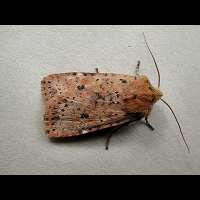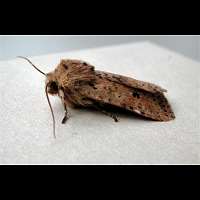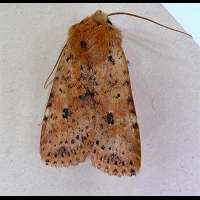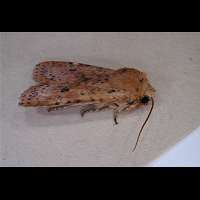Dotted Chestnut Conistra rubiginea
The number of spots may vary a little, but normally the Dotted Chestnut is not very variable in colours or markings. Once dead the colours quickly fade away to a light vague brownish yellow. Even the furry head and shoulders between the wings are dotted. This also is a good characteristic, for most other Chestnuts from the Conistra-genus are not marked at all on head or between the wings. The Dotted Chestnut thus is unmistakable. It is quite variable in size, having a wingspan of 32 to 40 mm.
The eggs are laid in spring. They are deposited in trees and when young the caterpillars do live in trees only. Older larvae however may drop to the ground to complete their development on low growing plants such as Dandelion. Accept when present on Apple trees the larvae are rarely ever seen in the wild. The caterpillar of the Dotted Chestnut is very hairy, unusual for members of this genus. It is blackish brown with a faint black dorsal line and black, cross-shaped markings on the back. The head is always black. It may grow to be 38 to 44mm long.
The Dotted Chestnut is a typical winter moth. It appears in September and October. On warmer winter days it may fly about, even in January. In colder winters it remains in hibernation from November to March. It is attracted to light, but more to sugar. In autumn it is not uncommon in gardens, for it visits the flowers of Ivy. In spring it is seen on catkins. It prefers light forests with lots of undergrow, like forests on heath. It is a local species in southern parts of England and Wales only. Not found in Scotland and Ireland. In other parts of Europe a rare and usually very local species too.
The number of spots may vary a little, but normally the Dotted Chestnut is not very variable in colours or markings. Once dead the colours quickly fade away to a light vague brownish yellow. Even the furry head and shoulders between the wings are dotted. This also is a good characteristic, for most other Chestnuts from the Conistra-genus are not marked at all on head or between the wings. The Dotted Chestnut thus is unmistakable. It is quite variable in size, having a wingspan of 32 to 40 mm.
The eggs are laid in spring. They are deposited in trees and when young the caterpillars do live in trees only. Older larvae however may drop to the ground to complete their development on low growing plants such as Dandelion. Accept when present on Apple trees the larvae are rarely ever seen in the wild. The caterpillar of the Dotted Chestnut is very hairy, unusual for members of this genus. It is blackish brown with a faint black dorsal line and black, cross-shaped markings on the back. The head is always black. It may grow to be 38 to 44mm long.
The Dotted Chestnut is a typical winter moth. It appears in September and October. On warmer winter days it may fly about, even in January. In colder winters it remains in hibernation from November to March. It is attracted to light, but more to sugar. In autumn it is not uncommon in gardens, for it visits the flowers of Ivy. In spring it is seen on catkins. It prefers light forests with lots of undergrow, like forests on heath. It is a local species in southern parts of England and Wales only. Not found in Scotland and Ireland. In other parts of Europe a rare and usually very local species too.








